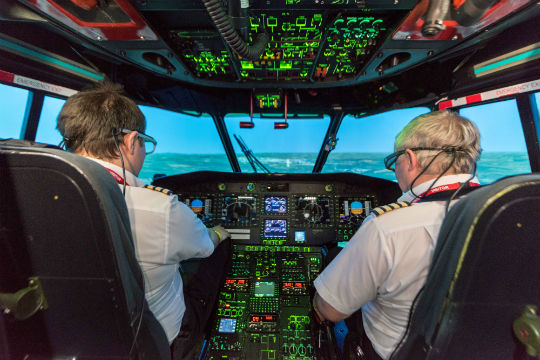
HeliOffshore has commissioned industry experts Jarvis Bagshaw Ltd to conduct the research, which has seen 26 pilots participate in the first phase of observational study. HeliOffshore Photo
The offshore helicopter industry’s unrelenting commitment to safety has again been demonstrated with the launch of collaborative research in Aberdeen to further enhance pilot performance in the cockpit.
“A safety priority across the industry is to optimise the training and tools provided to offshore crews,” said Gretchen Haskins, chief executive officer of the global offshore helicopter association, HeliOffshore. “This is the focus of HeliOffshore’s uniquely collaborative eye-tracking research, which started this month. We are using state of the art techniques to understand more about how pilots monitor cockpit instruments during flight,” said Haskins.
HeliOffshore has commissioned industry experts Jarvis Bagshaw Ltd to conduct the research, which has seen 26 pilots participate in the first phase of observational study.
“We will use the results to improve training and standard operating procedures, and give feedback to the manufacturers about the design of automation and cockpits,” said Francois Lassale, HeliOffshore’s operations director.
The research records pilot activity in a situation where visibility is such that the crew need to rely on aircraft instruments, rather than outside visual cues. It replicates a realistic workload that immerses both crew members in duties and has a number of different task components to be monitored.
The pilots enter a simulator and put on eye-tracking glasses. These are connected to a system that combines a camera with an infrared light source that illuminates the eye with bursts of non-harmful infrared light.
“Some light disappears into the pupil and some of it bounces off the iris, cornea, eyelid or surrounding skin. These areas reflect different levels of infrared light, which is picked up by the camera and then analyzed to reveal which instruments are monitored during which periods of flight,” said Lassale.
The study is the result of collaboration between a number of HeliOffshore members.
“We had a great response from members,” said Haskins. “Airbus Helicopters UK donated time in their Aberdeen-based H225 simulator and pilots from Bond Offshore, Bristow and CHC Helicopter are participating in the study.”
Dr. Steve Jarvis, from Jarvis Bagshaw Ltd said that vulnerabilities in flight path and automation monitoring can occur.
“It’s part of the normal human condition and as a result of other tasks which compete for pilots’ attention. This research is identifying why and when those are likely to happen to inform future initiatives,” said Jarvis.
The anonymized results will be shared with HeliOffshore members at the association’s annual conference in Prague, from May 13 to 15, 2016, after which a working group will determine the best way possible to further improve safety; through pilot training, procedures, policy and system design.









